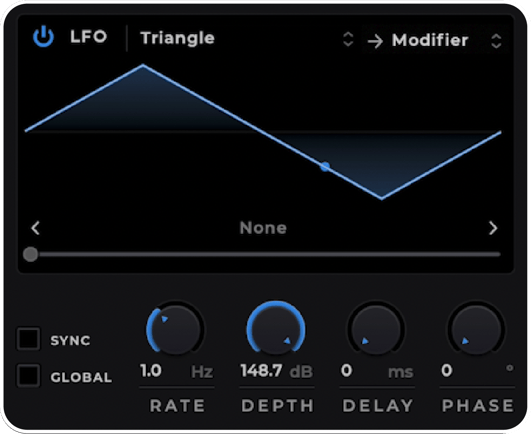Tutorial: Programming a Synth - Frequency Modulation Explained - Part II [10/12]
Welcome back to our series on "How to Program a Synth" with our synthesizer SkyDust 3D! Let's continue to dive into the fascinating world of Frequency Modulation (FM) synthesis.
Modulations
Modulations are a set of advanced features that will add richness and movement to your sounds. They can be applied to multiple aspects of your sound, such as pitch, amplitude, filter cutoff frequency, among others.
Practical Application with SkyDust 3D
Pitch Modulation
First, we'll start with the pitch tab. To introduce a slight detune at the beginning of the sound:
- Adjust the detune for a subtle effect.

- Apply this adjustment to all oscillators.
- For the last two oscillators, add pitch modulation using an LFO (Low-Frequency Oscillator) for a dynamic pitch change.

Next, we'll create movement in our sustained oscillators (oscillators 3, 5, 7, and 8):
- Adjust the azimuth movement for oscillator 3.

- Copy this setting to oscillators 5, 7, and 8 with phase shifts to avoid them staying in the same place.

By doing this, we ensure each oscillator moves uniquely, adding depth to the sound.
Dynamics with Velocity
To add dynamics based on how hard you play the keys:
- Use note on velocity to control the oscillator gain.

- Set an offset to balance the gain across all oscillators.

- At maximum velocity, the level is set to 50%, and at minimum, it drops to -50 dB.

Additionally, control the modulation gain of oscillator 2, which acts as the attack oscillator:
- Maximum gain set to +2 dB.
- Minimum gain set to -30 dB.

This results in brighter, more intense sounds when played with high velocity and smoother sounds with low velocity.
Enhancing the Sound with Effects
Now, let's add some effects to our sound:
- Distortion: Add a subtle overdrive without clipping by setting the gain to +10 and compensating for any lost gain.

- Delay: Adjust the delay for a longer, more pronounced effect with increased gain and feedback.

- Phaser: Maintain the current phaser settings for a consistent effect.

Modulating the Wave Modifier
For oscillators 7 and 8:
- Add a wave modifier.

- Control it with an LFO set to a triangle wave with full depth.

- Use an envelope generator (EG) to control the modulation intensity, starting slow and sustaining at maximum.

This setup ensures the modulation builds up gradually.Adding a Filter Controlled by Velocity
To further shape the sound dynamically:
- Add a filter and map the velocity to control the filter's cutoff.

- Set the filter to a high value with resonance.

- Use the LFO to control the filter, creating an automatic wah-wah effect.

Macro Control
Finally, we'll use the modulation wheel to control various parameters via macro A:
- Control the EG sustain and attack values.

- Adjust the effects' dry/wet mix.
By setting macro A to influence these parameters, you can achieve a versatile, expressive sound.
Mastering Modulations
With all these modulations and effects in place, the final sound is dynamic and rich with movement. As you can see, modulations can add a lot of flavor to your sound. If you like this particular preset, you can download it below.
Happy synthesizing!
Stay tuned and join the revolution!
Topics: Sound Particles, Sound Design, Tutorials, 3D audio, Surround Sound, Music, synth, virtual instrument, synthesizer, SkyDust3D

